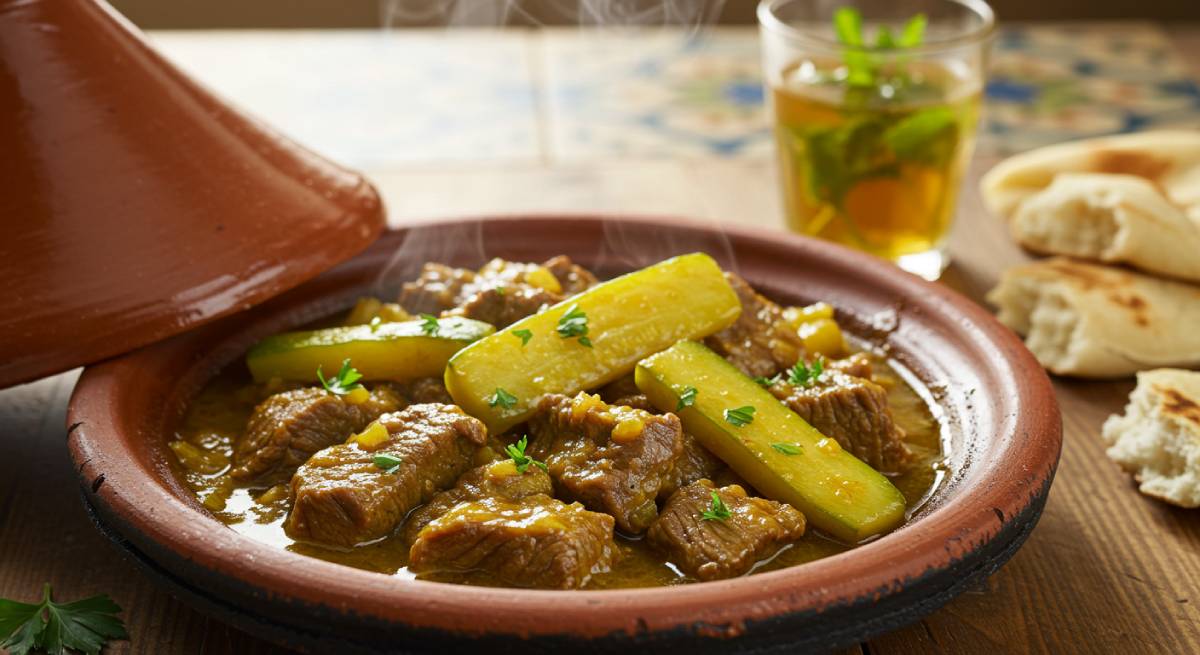
Table of Contents
You’re here for a good plate.
So let’s start where this dish lives for me. A small workers’ spot by the taxi stand in Rabat. Ba Omar’s place. That’s where you find beef tagine with zucchini done right, week after week.
Every Wednesday, the steam rises and the windows fog up. You see beef tagine with zucchini on the board. Sometimes there’s a handful of peas in the pot. A couple of chicken tagines are also simmering with the same humble vegetables.
It’s a tight room. Feels smaller when the drivers squeeze in.
But the heart? Big.
If you know a good plate when you see it, you grab a seat and wait for your turn.
Now, the kitchen. It’s a duet. Fatima builds the flavor. Slow. Patient. You can smell the onion getting sweet, the ginger waking up the pot, the turmeric blooming in the oil.
Then there’s Ba Omar. He watches the fire like it’s a living thing. Careful hands. Eyes on the simmer. They work side by side and send out tagines that you won’t be able to copy easily at home.
You’ll try. You should try.
This beef tagine with zucchini is simple on paper, but it tastes deep and clean. Here’s the trick you’ll use: add the zucchini late. You want tender, not mush. You want the sauce to keep its body, not get washed out with extra water.
Keep that in your pocket. You’ll need it.
I asked for the secret once. Maybe you would, too. He laughed, the kind of laugh that fills the room, pointed straight at Fatima, and said, “Ask her. She makes the magic with her hands.”
Then he leaned in like we were two drivers trading road tips.
Low heat. Slow heat.
That’s the line you remember when your pot starts rushing you.
At home, keep it honest. A little water. Not much. Let time do the work. Bring it to a glossy finish so the sauce clings to the meat and kisses the zucchini.
Then you bring bread. Always bring bread.
You’ll chase the last spoonful. That’s the whole road in one plate, humble, steady, and good.
And you? You’ll taste why Wednesday matters.
What This Beef Tagine Is
This is a Moroccan home dish. Beef tagine with zucchini. Simple parts, deep flavor.

You cook beef low and slow with ginger, turmeric, onion, and just a splash of water. Not much. Let it take its time.
Then you add the zucchini near the end. You want it tender, not falling apart. And you don’t want it watering down the pot.
The result you’re after is a clean, shiny broth. Not a soup that swallows the meat.
You’ll see it more when zucchini is in season, late spring through summer, and still good into early fall, where the markets stay kind. In Rabat, stalls stack the green batons in neat piles. Fatima picks them small to medium. Firm. Bright.
They keep their shape. That matters.
Where does it sit on the Moroccan table? Right in the middle of everyday life.
It’s not a feast dish with prunes and cinnamon and big speeches. It’s lunch with workers. It’s a family plate after school. Bread on the side. Maybe a small salad if the tomatoes are honest. It feeds drivers and neighbors, and anyone who walks in hungry.
Flavor? Think warm ginger, soft onion, and a gentle push of turmeric. Saffron, if you like, but it’s optional here. Black pepper brings the edges in. Parsley or cilantro, your call, or the cook’s. Both work.
When the zucchini hits that sweet spot, it adds a fresh, green lift. The beef stays the star. The zucchini doesn’t steal the scene. It just brightens the plate.
If you’ve made tagines before, you already know the rule. Go easy on the water. Add a little only when the pot asks for it. That’s how you keep the sauce honest.
Let the meat give what it can. Reduce to a gloss. Then fold the zucchini in and catch the perfect moment. The knife slips in easily. Not too soft. Not raw.
That’s the sweet spot.
Say it plain: this dish is honest food.
You make it for people who work. You make it for someone who needs a steady plate. You make it for yourself on a Wednesday when you want something that tastes like home.
If that’s you today, good. You’re in the right kitchen.
Ingredients For This Beef Tagine
This isn’t about a long shopping list. It’s about a few honest pieces that know their job. Get these right, and the pot will thank you.
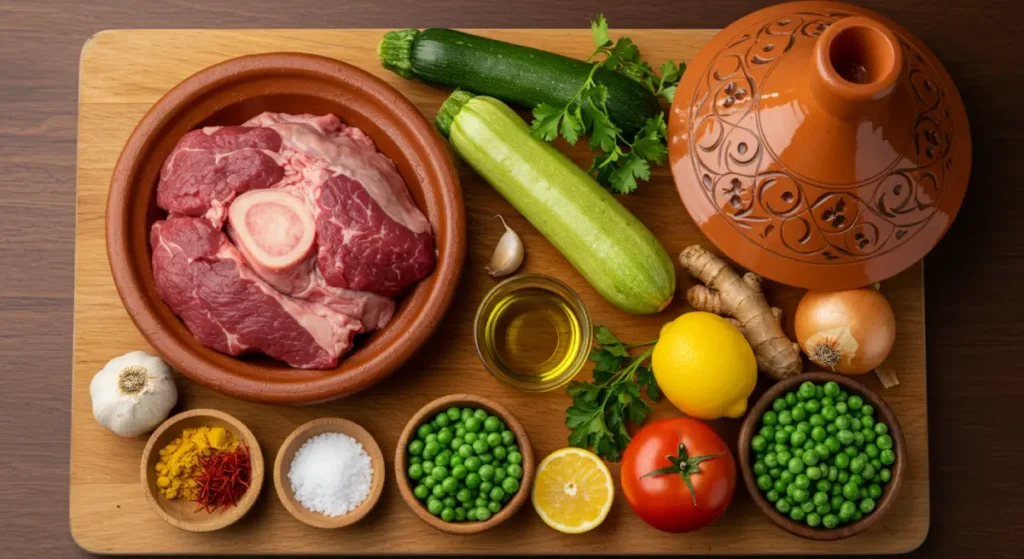
The Essentials
- Beef shank or shoulder, bone-in if you can
- Small to medium zucchini, firm and bright green
- One large onion
- A couple of cloves of garlic
- Ground ginger
- Turmeric
- Black pepper
- Good olive oil
- Sea salt
Optional Accents
- A small pinch of saffron
- A handful of parsley or cilantro
- A ripe tomato, peeled and grated
- A thin sliver of preserved lemon
- A handful of peas (for the “Wednesday” touch)
A Word on These Ingredients
Beef: Go with shank or shoulder. Bone-in if you can. More flavor. More body in the sauce. If you only have boneless, it still works, just watch the water and give it time.
Zucchini: Small to medium. Firm. Bright green. You want pieces that hold their shape. Cut them into thick batons or chunky rounds so they don’t melt away in the pot.
Onion: One large, sliced thin. It softens early and sweetens the base. That sweetness matters with the warm spices.
Garlic: A couple of cloves, minced. Not too much. Let it lift the pot, not shout over it.
Spices: Ground ginger. Turmeric. Black pepper. A small pinch of saffron if you have it, but it’s optional here. These spices make the broth warm and golden without turning it heavy.
Herbs: Parsley or cilantro, your call. Both work. Chop a handful for the finish. It wakes the plate up at the end.
Olive Oil: A good splash to bloom the spices and soften the onions. Don’t be shy, but don’t drown it either.
Water: Add little by little. Only as the pot asks. This keeps the sauce honest and lets the beef give what it can.
Salt: Season early and taste again at the end. The reduction changes the salt line, so check before you serve.
Optional Accents: The tomato adds a gentle red note. The preserved lemon, a bright edge. The peas, a sweet pop like Ba Omar makes. None of this is required, the dish stands strong without it, but they’re good moves when the mood hits.
What you hold in your hands is simple food. Good pieces. Clean flavors. If you choose bone-in beef and add water with patience, the sauce will gloss up on its own.
Then the zucchini goes in late and stays tender. That’s the balance you’re chasing.
See the Magic Happen: The Video Guide
Words on a page can guide the hands, but seeing the process brings the flavor to life. Before you light the flame, take a minute. Watch the steam rise, see how the sauce gets its honest shine, and feel the patient rhythm of a tagine made the right way. This is your visual guide to that perfect plate.
Equipment For Your Beef Tagine
You don’t need a fancy kitchen for this. A good, heavy pot. A sharp knife. The real work is done with your hands and your patience. Here’s what I use.
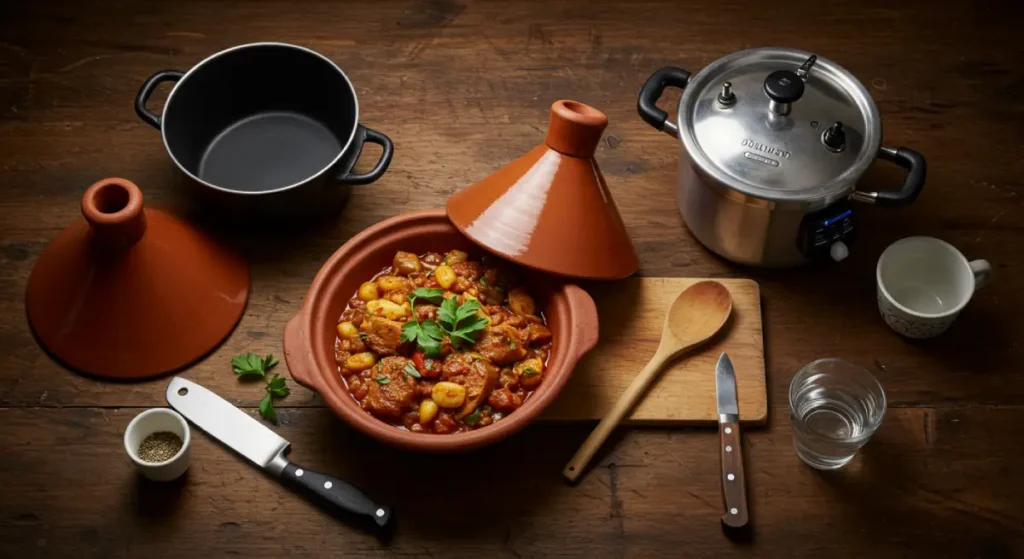
The Cooking Vessel (Your Pot)
- Clay Tagine: If you have one, great. It gives a gentle heat and a special aroma. Use a heat diffuser on gas. Keep the flame low. Let the pot warm up slowly so it doesn’t crack. This dish loves that slow breath of a clay lid.
- Dutch Oven or Heavy Pot: Works perfectly. Tight lid. Even heat. You’ll get a steady simmer and a clean reduction. If the heat runs hot, pull it back. You want a soft bubble, not a boil that beats up the zucchini.
- Pressure Cooker (Optional): Short on time? You can soften the beef under pressure first. Keep the liquid low, just enough. Then finish uncovered to reduce and gloss the sauce. Add your zucchini at the end so it stays tender and bright, not mushy.
Simple Tools
- Knife and Board: A sharp knife for clean zucchini cuts, thick batons or chunky rounds. A dull blade squashes the flesh and leads to mush. You don’t want that.
- Wooden Spoon: Gentle on the pot. Easy to scrape the fond without scratching. Helps you feel the sauce thickening as you stir.
- Serving Dish: A warm shallow bowl or a serving platter with a lip. Bread on the side. Always. If you’re the salad type, a simple tomato-onion plate sits well next to it.
The Most Important “Equipment”
- Heat Control: This is the real tool. Keep it low. Adjust by ear and eye. If the pot talks too much, hard bubbling, quiet it. If it sleeps, no movement, nudge it. You’re driving the road here.
- Water Control: A small cup nearby. Add a splash only when the pot asks. You’ll hear it. See it. Little by little. That’s how the sauce stays honest and ends glossy.
If you’ve cooked tagines before, you already know: the best tool is patience. Low heat. Slow heat. That’s how the beef relaxes and the zucchini stays itself. You’ll taste the difference.
Step-by-Step Method
Now for the road itself. There are no tricks here, just steady hands and a soft flame. We’ll build this plate one good step at a time.
1. Build the base
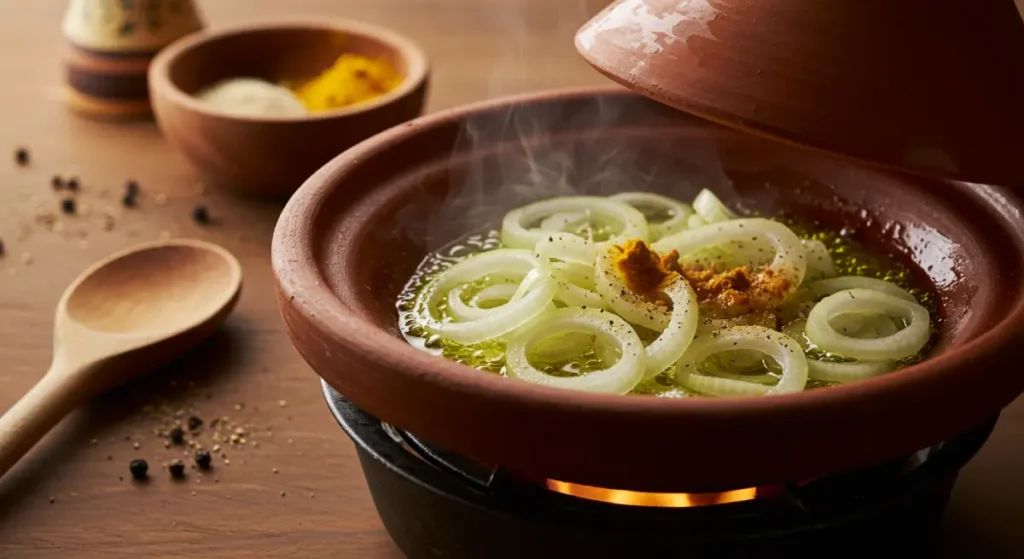
Set your pot over low heat. Add a good splash of olive oil. Slide in the sliced onion with a pinch of salt. Let it soften, slowly. No rush. When it turns sweet and a little glassy, stir in the ground ginger and turmeric. Add a touch of black pepper. Give the spices a minute in the oil so they bloom. You’ll smell it come alive.
2. Add the beef
Put in the beef, shank or shoulder, bone-in if you’ve got it. Stir so every piece wears that spice oil. Let it sit on the heat for a minute or two. Just enough time for the meat and spices to meet. Keep the flame gentle. You’re coaxing, not frying hard.
3. Water, but just a little
Pour in a small splash of water. Not much. The pot needs moisture, not a bath. Cover and go low and slow. If it dries too far, add another small splash. Only when the pot asks. You guide the road, you don’t flood it.
4. Let time do its job
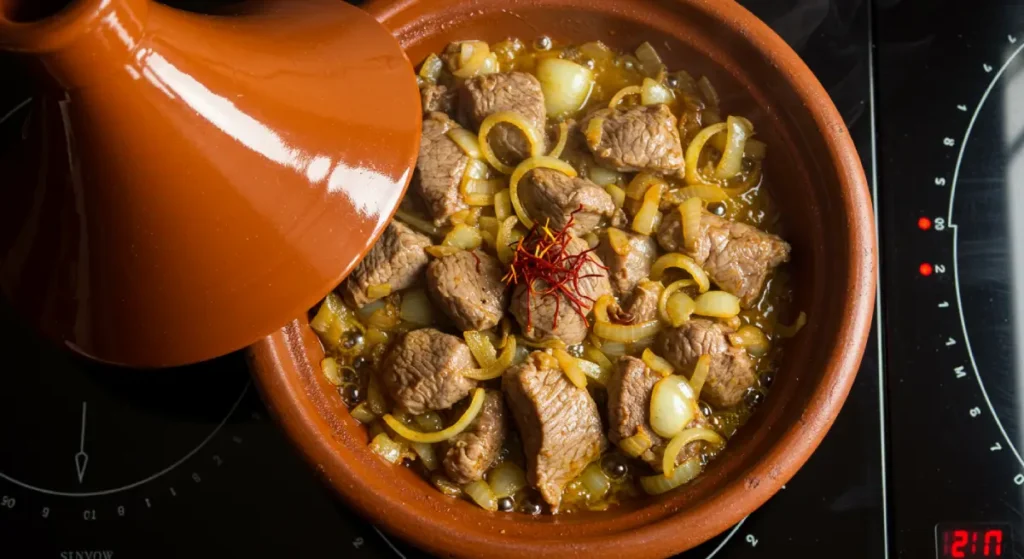
Keep the simmer soft. The meat will relax. Check now and then. Turn pieces if you like. Taste the liquid for salt and warmth. If you want saffron, add a small pinch now, or in the next tiny top-up of water. Optional, but good.
5. Zucchini prep
While the beef softens, cut the zucchini into thick batons or chunky rounds. Firm pieces hold their shape. If you like a touch of green at the end, chop parsley or cilantro and set it aside. Your call. Both work.
6. Judge the beef
When a fork slips in with little push, you’re close. Ease off the lid to let the sauce tighten a bit. You want shine, not soup. If it’s thin, leave it uncovered and let a quiet bubble thicken it. Calm heat. No rolling boil.
7. Add the zucchini late
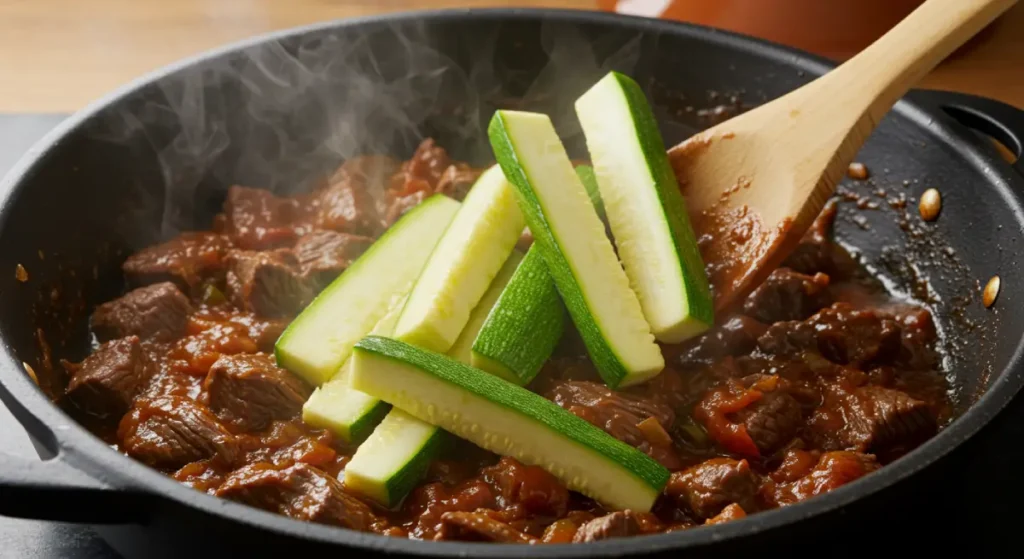
Slip the zucchini into the pot. Stir gently so you don’t crush it. Keep the heat soft. Cook until a knife slides in easily. Not much. Not raw. That sweet middle. If the pot looks dry, a small splash of water is fine. Stay in control.
8. Finish and brighten
Taste for salt. Add pepper if it needs a small edge. Fold in parsley or cilantro at the end. If you want a tiny lift, save it for another day: a sliver of preserved lemon or a spoon of grated ripe tomato. Optional moves. Today, keep it clean.
9. Gloss check
Look at the sauce. It should coat a spoon and cling to the beef. If it’s thin, give it another minute uncovered. If it’s too tight, a spoonful of water smooths it out. You’re steering the last meters now.
10. Serve
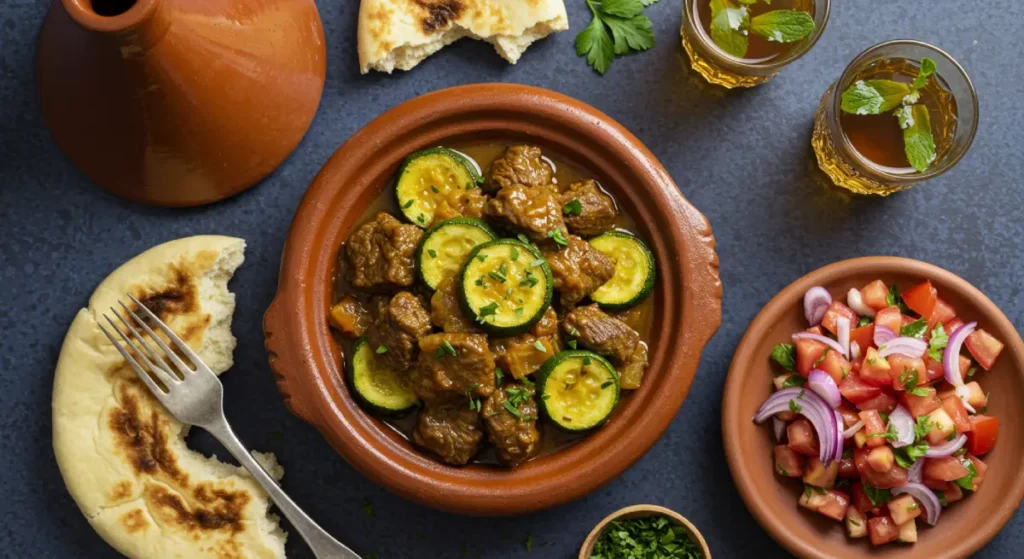
Bring it to the table in a warm shallow bowl or a platter with a lip. The zucchini on top looks good. Bread on the side. Always. If you like a crisp counterpoint, a small tomato–onion salad sits well next to it. Then eat. Take a quiet minute. That’s the point.
Doneness & Texture Cues
A timer doesn’t know when a tagine is ready. Your eyes, your nose, your spoon—they are the real timers. Here’s what they’re looking for.
- Beef tenderness: You’re looking for relaxed meat. The fork goes in with little push. Not shredding, not tough. Somewhere easy. If it still fights back, give it more time on a soft simmer. No rush. Time is flavor.
- Sauce consistency: Think gloss, not soup. When you stir, the spoon should come up coated—thin velvet, not watery. If it runs like broth, take the lid off and let a quiet bubble tighten it. If it turns too tight, a spoon of water smooths it out. Small moves. You’re steering, not correcting a crash.
- Zucchini doneness: The knife slides in easily. The piece holds its shape. No collapse. If it bends like wet paper, you went too far. If it squeaks or feels starchy, give it another minute. Aim for tender with a little life left.
- Aromatics and spice: Smell the pot. Onion should read sweet and mellow. Ginger should feel warm, not sharp. Turmeric should glow in the sauce without shouting. If it tastes flat, a pinch of salt or a breath of pepper brings the edges back. Small pinches. Taste, then act.
- Salt line: Reduce first, salt last. As the sauce thickens, the salt gets louder. So taste at the end before you touch the shaker. If you added preserved lemon another day, remember it’s salty too. Respect the balance.
- Fat and shine: You want a gentle sheen on top, not a greasy puddle. If there’s too much oil, tilt the pot and spoon off a little. If it looks dull, a slow minute uncovered often wakes up the shine. Gloss is a sign that the sauce is ready to hug the meat.
- Bite test plate: Pull one piece of beef and one of zucchini. Set them on a small plate. Let them sit for 30 seconds. Taste. It’s easier to judge away from the steam. If both pieces taste like they belong together, deep beef, fresh green, warm spice, you’re there.
- Heat discipline: Listen to the bubble. If it chatters hard, you’re boiling off flavor and beating up the zucchini. Turn it down. If it’s silent and sleepy, nudge it up a touch. The right simmer sounds like quiet breathing.
- Final look: Color should be warm gold with green standing bright on top. Sauce should gather at the edges of the platter, not flood it. When you spoon it over bread, it should sink in slowly and leave a shine. That’s your yes.
When all these small signs line up, the dish is speaking to you. It’s telling you it’s ready. That’s the moment to listen.
Beef Tagine Variations & Substitutions
Once you know the road, you can take a small turn here and there. This dish is honest, but it has friendly neighbors. Here are a few you might meet.
On the Meat and Vegetables
- Beef Cuts: The shank or shoulder is the sweet spot. Bone-in gives you more body and flavor. If you only have boneless, it still works, just keep an eye on the water and give it time.
- Lamb Instead of Beef: You can swap beef for lamb shoulder or shank. Same method. Low heat. Slow heat. Lamb will bring a rounder, fuller taste. Watch the fat; skim a little if it pools on top.
- Zucchini Options: Small to medium zucchini hold their shape best. If all you’ve got are bigger ones, remove the soft center and use the firmer outer flesh. Cut thick. Batons or chunky rounds. You want pieces that come out tender, not slumped.
Adding Flavor Accents
- Peas on Wednesdays: A handful of peas near the end, like Ba Omar does midweek, brings a small sweet pop and a nice green. Add them with the zucchini so they stay bright.
- Tomato Accent: A ripe tomato, peeled and grated, can go in with the spices and onions or toward the end before reduction. It brings a soft red note and a gentle acidity. Keep it light, you still want the broth clean, not heavy.
- Saffron or No Saffron: A small pinch is lovely if you have it. It deepens the aroma and warms the color. If not, no problem. Ginger and turmeric already carry the dish.
- Herbs (Parsley or Cilantro): Choose your team. Parsley reads fresh and clean. Cilantro leans greener and bolder. Both work. Fold it in right at the end so it stays lively.
- Spice Tweaks: Black pepper is your edge. If you want a tiny lift, a whisper of paprika can join the pot, but keep it modest. You’re not building heat here, you’re rounding the corners.
- Preserved Lemon: A thin sliver at the finish brightens the whole plate. Go easy. It’s salty and strong. If you add it, taste before salting.
- Chickpeas: If you want a little extra body without changing the soul of the dish, add a small handful of cooked chickpeas near the end. Warm them through. They soak up flavor and don’t fight the zucchini.
Technique & Time-Savers
- Cooking Vessel: A clay tagine gives you a gentle breath and a special smell. A Dutch oven gives you steady heat and clean reduction. Both roads lead home. Use what you have, keep the flame soft, and control the water. That’s what matters.
- Make it Weeknight-Friendly: Pressure-cook the beef with just enough water until tender. Then open the pot, reduce to a gloss, and finish with zucchini on low heat.
Same result, less time. Still low and slow for the finish.
Common Road Bumps & How to Fix Them
- If the Sauce Goes Thin: Don’t panic. Lid off. Quiet bubble. A few minutes. It will tighten. If it tightens too hard, one spoon of water smooths it. Small moves.
- If the Zucchini Turned Too Soft: It happens. Next time, cut it thicker and add it later. For now, keep the sauce glossy and serve gently so it holds together on the plate.
You don’t need all these moves on the same day. Pick one. Maybe two. Keep the heart of the dish the same, clean broth, tender beef, zucchini with life left in it. That’s the point.
What to Serve With Beef Tagine
This tagine doesn’t need a big crowd on the plate. It likes a few good, honest friends. Here are the ones it calls for most often.
The Essentials
- Bread: Bring good Moroccan bread if you have it. Any honest, crusty bread works. You’ll need it to chase the sauce. Tear, dip, repeat. That’s the meal.
- A Simple Salad: Go quick: ripe tomato, thin onion. Pinch of salt. Squeeze of lemon. A light line of olive oil. If you’ve got parsley or cilantro on the board, tear a little. That’s it.
Other Good Company
- Couscous (Optional): Want it to eat a bit bigger? Spoon the tagine over plain couscous. Keep it simple. Just hydrate, fluff, a thread of olive oil, and a pinch of salt. Don’t overwork it. Let the sauce speak.
- Olives on the Side: A small dish of green olives sits well with this plate. Salty bite. Good with the beef. Don’t overdo it, just a few.
- Table Accents: A very thin sliver of preserved lemon for a bright edge. A glass of mint tea, if that’s your habit. Or just cold water. Keep it simple.
A Final Tip on Plating
Plate the beef first. Nestle the zucchini on top. Spoon the glossy sauce where it shines. Finish with a pinch of parsley or cilantro. It looks good. It tastes better.
Say it plain: you don’t need much. Bread, a fresh salad, and this tagine. That’s lunch. That’s Wednesday. That’s home.
Make-Ahead, Storage, Reheating
A good tagine rests well. The flavor gets deeper, rounder. But you have to wake it up gently. Here’s how you treat it right.
Making it Ahead
- The Method: Cook the beef all the way to a glossy finish, but stop before adding the zucchini. Let it cool completely, then chill overnight. The next day, warm the beef back up. If the sauce has loosened, let it reduce to a shine again. Now, slip in fresh zucchini at the end to finish the dish. It will be perfect.
Storing Leftovers
- The Best Way: If you can, store the beef and the zucchini in separate containers. The zucchini keeps its shape that way. Cooled and packed tight, they’re fine in the fridge for three days.
- Freezing: Freeze the beef with its sauce only. When you’re ready to eat, thaw and reheat it, then cook fresh zucchini to add at the end.
How to Reheat
- On the Stove (Best): Low heat, covered. Add a spoonful of water if the sauce is too tight. Let it come back to life slowly.
- In the Oven: Low heat, covered dish. 150–160°C (300–325°F) works well. Add a splash of water if needed.
- Microwave (Last Resort): It works in a pinch. Use short bursts and stir in between.
Final Touches & Fixes
- Fixing Texture: If the sauce is thin after the fridge, simmer it uncovered for a minute. Too tight? A splash of water over calm heat will smooth it out.
- Freshen the Finish: Wake the dish up with a final pinch of fresh parsley or cilantro before serving again.
When you serve it the next day, the rules are the same. Beef first. Zucchini on top. Sauce where it shines. And the bread close by.
Frequently Asked Questions (FAQs)
Why is my sauce watery?
Too much water, too soon. Add small splashes only when the pot asks. Reduce uncovered at the end until it shines. Keep the simmer quiet, not boiling hard.
My zucchini keeps turning mushy. What am I doing wrong?
Cut it thicker. Add it later. Keep the heat soft. Stop when a knife slides in easily, but the piece still holds shape.
Can I use boneless beef?
Yes. Shoulder works. You’ll miss some body from the bone, so be patient with the reduction and watch the water.
What spices are essential?
Ground ginger, turmeric, and black pepper. Saffron is optional. Onion does a lot of the work for sweetness and depth.
Parsley or cilantro?
Either. Parsley is clean and fresh. Cilantro is greener and bolder. Add at the end so it stays lively.
Can I add a tomato?
A small ripe tomato, peeled and grated, is fine. Add early with the onions for a soft base, or late for a fresher note. Keep it light—this dish wants a clean broth.
What about preserved lemon?
A thin sliver at the finish wakes up the plate. Go easy—it’s salty and strong. Taste before you add more salt.
Can I pressure-cook the beef?
Yes. Little water, just enough. Cook until tender, then open, reduce to a gloss, and add zucchini at the end on gentle heat.
Best cuts of beef?
Shank or shoulder. Bone-in if you can. More flavor and better texture in the sauce.
How do I fix a split-looking sauce?
One spoon of water and a quick stir. Calm heat. It usually comes back together fast.
How do I serve it right?
Beef first. Zucchini on top. Spoon the glossy sauce where it shines. Bread on the side. Maybe a small tomato–onion salad for a clean counterpoint.
Can I make it ahead?
Yes. Stop before the zucchini. Chill overnight. The next day, warm the beef, reduce to a simmer if needed, then add fresh zucchini to finish.
A Final Word from the Road
This beef tagine with zucchini isn’t a trick. It’s patience and small choices.
Low heat. Little water. A sauce that turns glossy when it’s ready, not when a clock tells it to.
You add the zucchini late so it stays tender and keeps the broth clean.
Then you bring bread. Always bread.
Make it on a Wednesday if you want to taste the road with me. Or any day you need steady food that doesn’t shout. Ginger warm, onion soft, turmeric glowing in the pot.
Beef first. Zucchini on top. Sauce where it shines.
That’s the plate.
Besseha!
To your health and happiness.
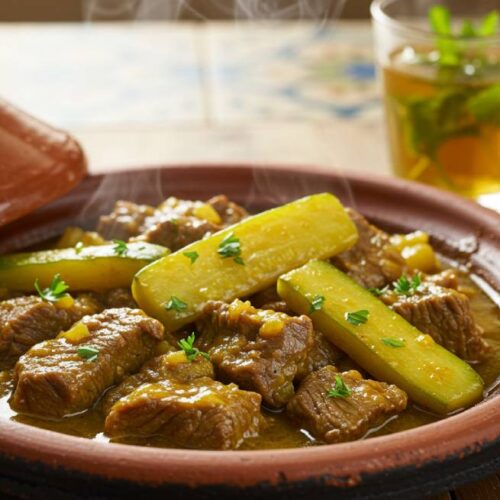
Beef Tagine with Zucchini
Equipment
- clay tagine with diffuser or Dutch oven/heavy pot; optional pressure cooker
Ingredients
Ingredient
- 2 lb 900 g beef shank or shoulder, bone-in if possible; large chunks
- 2 –3 small to medium zucchini firm; cut into thick batons or chunky rounds
- 1 large onion thinly sliced
- 2 garlic cloves minced
- 2 –3 tbsp olive oil
- 1 tsp ground ginger
- 1 tsp ground turmeric
- 1/2 –3/4 tsp black pepper to taste
- Pinch of saffron optional
- Salt to taste
- Small handful of parsley or cilantro chopped, for finishing
- Optional accents
- 1 ripe tomato peeled and grated (light red note)
- Thin sliver preserved lemon bright finish
- Small handful of peas Wednesday touch
Instructions
Instructions
- Build the base
- Set the pot over low heat. Add olive oil, onion, and a pinch of salt. Soften slowly until sweet and a little glassy. Stir in ginger, turmeric, and a touch of black pepper. Let spices bloom 1 minute. Add grated tomato now if using.
- Add the beef
- Add beef chunks. Stir to coat in the spice oil. Gentle heat for 1–2 minutes so the meat and spices meet. Not hard frying.
- Add water—only a splash.
- Pour in a small splash of water. Cover and keep to a soft simmer. Add tiny splashes only when the pot asks. If using saffron, add a pinch now or with the next splash.
- Low and slow
- Simmer until the beef is nearly tender. The fork should slide in with little push. Manage heat: quiet bubble, not a boil. Taste for salt and warmth as it cooks.
- Zucchini prep
- Cut zucchini into thick batons or chunky rounds. Keep them firm so they hold shape. Chop parsley or cilantro for finishing.
- Reduce to gloss
- When the beef is close, uncover for a few minutes to tighten the sauce. Aim for shiny, not soupy.
- Add zucchini late
- Slip zucchini in. Stir gently. Keep the heat soft. Cook until a knife slides in easily. Not mush, not raw. Add peas now if using.
- Finish and serve
- Taste for salt and pepper. Fold in parsley or cilantro. Optional: a thin sliver of preserved lemon at the end. Serve in a warm shallow bowl. Beef first, zucchini on top, glossy sauce over. Bread on the side.
Notes
- Pressure cooker option: Cook beef with minimal water until tender. Open, reduce to gloss, then add zucchini and finish gently on low heat.
- Make-ahead: Cook beef to a glossy, stop before zucchini. Chill overnight. Next day, reheat, re-gloss if loosened, add fresh zucchini to finish.
A Note on Nutrition
I am a cook, a storyteller, not a man with a white coat and a laboratory. The numbers you see below are an honest estimate, calculated with an online tool. They are a good guide to help you understand the plate in front of you.
Think of this as a good road map, not a scientific GPS reading. The final numbers will change depending on the cut of beef you use, the amount of oil, and of course, how much bread you use to chase that last bit of sauce.
Nutrition Information (Estimated)
Per serving, based on 4 servings. Calculated using beef shank and essential ingredients only.
| Nutrient | Amount |
| Calories | ~ 580 kcal |
| Protein | ~ 45 g |
| Fat | ~ 38 g |
| Saturated Fat | ~ 14 g |
| Carbohydrates | ~ 15 g |
| Fiber | ~ 4 g |
| Sugars | ~ 8 g |
| Sodium | ~ 750 mg |
The Language of My Kitchen
In Morocco, some words carry the weight of a whole story. They don’t always have a perfect translation, but they have a taste. Here are a few you will hear on your journey with our food.
- Tagine (or Tajine): This word does double duty, my friend. It is the name of the conical clay pot, the one with the tall lid that lets the steam dance and fall back down on the food. But it is also the name of the dish we cook inside it—the slow-cooked stew itself. The tagine is the house, and it is also the family that lives inside.
- Besseha (or B’saha): You will hear this at the end of every good meal in Morocco. The simple translation is “to your health.” But the feeling is much bigger. It is a wish for happiness, for satisfaction, for the food to bring you strength and joy. It is our way of saying, “May this meal nourish you, body and soul.”
- Ras el Hanout: This means “head of the shop.” It is not one spice, but a complex blend of many—sometimes thirty or more. Every spice seller (attar) has his own secret recipe, his signature. It is his best work in one jar. While we didn’t use it in this simple beef and zucchini dish, you will find it in many of our richer, more complex tagines.
A Letter from My Kitchen
The blog is for everyone. My newsletter is a little different. It’s a personal letter I send out from my kitchen, straight to your inbox, and it’s where I share the things I don’t put here.
A family secret. A story from my taxi days that a recipe brought back. The first look at the next dish before anyone else sees it. It’s our way of staying connected, like old friends sharing a pot of mint tea.
Put your name on the list, and I’ll see you there.
📩 Join Our Moroccan Foodie Community
Get the best Moroccan tagine recipes and seasonal culinary tips straight to your inbox.
Join Our Table Online
The meal doesn’t end when the plate is clean. The best part is sharing the story of what you made. On my social media, the kitchen is always open. It’s where I share more photos, small stories from the road, and what’s simmering on my stove right now.
Come, show me your tagine. Let me see the color of your sauce. Ask your questions. Let’s build this community of good cooks together, one beautiful plate at a time.
Pull Up a Chair and Talk to Me
A silent kitchen is a sad kitchen. This space below is our table, and your words are the final, most important ingredient.
Did you make this tagine? Tell me how it went. Did you run into any trouble on the road, or did you find a smooth path? Did you add a small touch of your own? All the best secrets are shared when the meal is done.
Your questions and your stories make this recipe better for everyone who comes next. I read every single one.
Talk to me.
